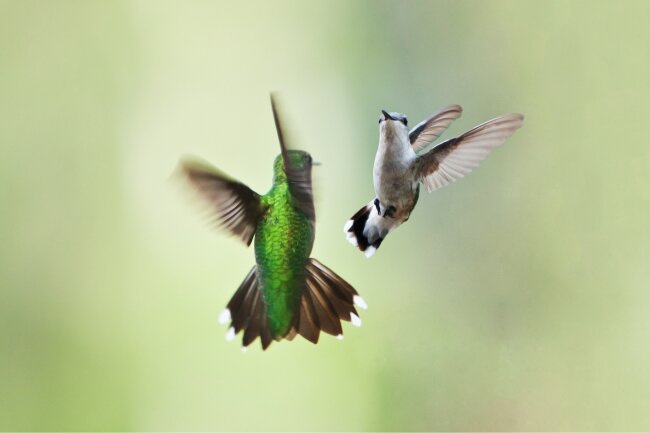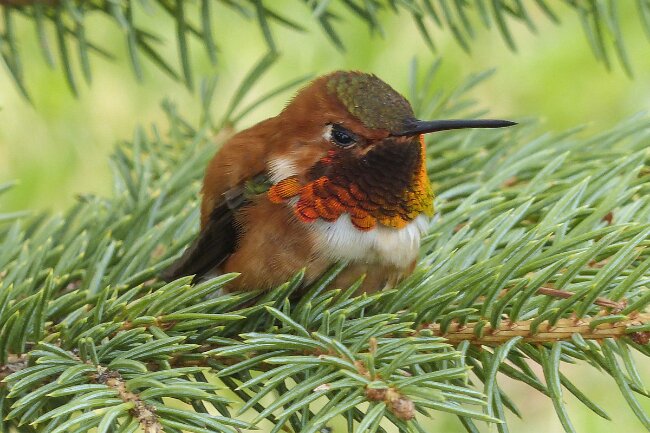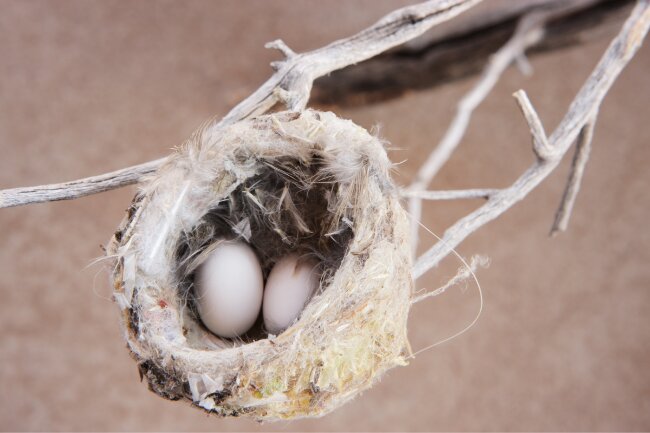Hummingbirds have busy lives, having to attract in a mate through fancy feathers and amazing aerial stunts, building their nests and raising their young. Males are all about the seduction process, whereas it’s the females that do all the child-raising.
Contents
Do hummingbirds mate for life?

Hummingbird species can live for around five years, however, during this time they will have multiple partners. Though we may think of them as romantic birds, because of their bright colours and the wonderful displays, hummingbirds do not mate for life.
| Mating Behavior | Description |
|---|---|
| Courtship Displays | Elaborate displays by males to attract females |
| Aerial Chases | Males chasing and diving at high speed to impress females |
| Hovering Dives | Males performing rapid dives while hovering |
| Wing Whirring | Rapid wing beats producing distinctive buzzing sound |
| Zigzag Flights | Zigzag flight patterns to showcase agility and strength |
Hummingbirds will generally mate many times with several different partners over the season. Males take no part in raising the young and instead spend their time trying to seduce as many different females as they can. Female hummingbirds are just as promiscuous, however, they spend less of their time sleeping around, as so much time is taken up by preparing a nest, laying the eggs and raising the young.
Also read: 4 Methods of Hummingbirds Communication
How do hummingbirds mate?

When it comes to mating, there is both the mechanics of the actual reproduction, but also the fascinating courtship rituals of hummingbirds themselves.
Hummingbirds are much less musical than many bird species. Some hummingbirds do ‘sing’ to display for females, however, these songs are mostly chirrups or piercing notes. Other species utilise their feather’s to make music, flying up high and diving low to create vibrations in their tails that create sounds similar to crickets or buzzing noises.
Perhaps more pleasing to human observers, however, at the visual mating displays. Many male hummingbirds are adorned with brightly coloured feathers, often iridescent reds, blues and greens. These feathers are themselves an advert for the little birds, telling watching females what a healthy and strong male they are looking at.
| Hummingbird Species | Mating Season |
|---|---|
| Ruby-throated Hummingbird | Spring and summer |
| Anna’s Hummingbird | Year-round, peaks in spring |
| Rufous Hummingbird | Spring and summer |
| Black-chinned Hummingbird | Spring and summer |
| Broad-tailed Hummingbird | Spring and summer |
Males will often perch somewhere in the sun, allowing their feathers to catch the light, so the females can fully admire their beauty. Many will also use these feathers as part of aerial displays or dances, that they put on for the females.

Like the state and colour of their feathers, these dances can help inform the females how strong the male is, requiring a great deal of strength and stamina to complete. Some males even have to go into training to learn how to complete the dance correctly, such as the marvellous spatuletail hummingbird, who learn from an experienced male.
Even the dives that many hummingbirds perform for their females, which may not seem as impressive to us, are an incredible feat for these tiny birds. The force they experience during these dives would be enough to render a human unconscious.
Once the wooing is completed, the mating itself can often seem surprisingly brief. Male hummingbirds do not have a penis, instead of having an opening known as a cloaca. If the female has decided to accept the male, she will allow him to mount her from behind as she perches on a branch.
The male will then press his cloaca against hers and sperm will be released, fertilising her eggs. Sex usually only lasts a few seconds. The male will then head out to spread his romantic ways further afield, finding other females that may be receptive to his advances.
How often do hummingbirds mate?
Hummingbirds will mate with a number of different partners over the season. This is because they want to produce as many young as possible. Males can mate more often as, as soon as they have mated they are ready to go again.
Females will not mate quite as often, firstly because they are fussier than males, being careful to pick the best specimen they can to father their young, and also because once they have mated they will be out of commission for several months as they have and raise their young.
Also read: Hummingbirds During the Winter… Migration Explained
What do hummingbird eggs look like?

The exact size and colours of a hummingbird egg will be somewhat determined by the species that has laid them, however, in general, hummingbird eggs are around the size of a pea, and weighs less than a paperclip.
Most species lay two eggs. Occasionally, a bird will lay just one, but this is less common.
When do hummingbirds lay eggs?
Like most bird species, eggs are usually laid in the spring and summer, this is because this is the time when the most food is regularly available. While hummingbirds are well known for their love of nectar, they will also eat small insects.
After a male has seduced the female, and the birds have mated, the female is on her own. Her first job will be to make a home to lay her eggs in. This means collecting materials, finding a suitable location, and finally building the structure. She will lay her eggs in a tiny nest, often made of grass and mosses.
The tiny cup of the nest is where she will lay her eggs when they are ready. Laying her egg is so exhausting that the female will usually rest between laying each egg, laying her first on day one and second on day two.
The female will then spend her time incubating the eggs. During this process, she will rarely leave the nest, spending around fifty minutes out of every hour incubating. In order to ensure the eggs don’t overheat, she will turn them gently throughout the day. Overheating could cook the eggs, resulting in the chick inside dying.
The eggs can take around twenty days to hatch. Once hatched, it’s time for her to feed up her chicks, ready for them to leave the nest.
When do hummingbirds have chicks?
Migrating hummingbirds tend to start nesting within five days of arriving at their destination. They will produce several broods a year, sometimes up to four or five. Most hummingbirds start nesting in May, however, non-migrating hummingbirds may start earlier depending on local weather conditions.
Once the chicks have hatched, they will usually take around three weeks to fledge. When they are born they are naked, without feathers to keep them warm. Having two chicks significantly increases their chance of survival, as they keep each other warm during cold periods.
How big are hummingbird chicks?
Hummingbird chicks start life pretty small, they have to be when you think they’re hatching from an egg as small as a pea. The size will vary between species and age, but most will be roughly an inch in length before they grow to full size.
Once they are fully feathered, the hummingbird chicks will leave the nest for their first flight. However, they won’t abandon their home completely, hanging around their mother for several weeks before they really leave home.
How do hummingbirds feed their young?
Hummingbird mums have a busy life feeding their young. They provide food by heading out and feeding, but rather than swallowing the tasty snacks for themselves, they will store it in their crop. The crop is a kind of bag in the oesophagus, where food can be placed and then later regurgitated.
Hummingbirds will feed their young nectar and small insects, the perfect mixture of sugars and proteins, ideal for growing chicks. She will regurgitate the food by inserting her beak into her open chick’s mouth and bringing up the food for them.
Chicks encourage their mother to feed them by making chirping noises and opening their mouths wide. However, in order to avoid calling in predators, they will often hunker down and remain silent the rest of the time.
Another way chicks avoid calling in predators is by sticking their bums out of the nest when they need a poo. The poo is propelled away from the nest, stopping predators from being able to hone into its location.
| Nesting Behavior | Description |
|---|---|
| Nest Construction | Females building small cup-shaped nests using plant materials |
| Nest Location | Nests placed in protected areas, often on branches or twigs |
| Incubation Period | Females incubating eggs for approximately 14-19 days |
| Chick Fledging | Young hummingbirds leaving the nest after 18-22 days |
| Multiple Broods | Some species may have multiple broods during the breeding season |
Hummingbird love
While it may be romantic to imagine tiny hummingbirds snuggle up in their nest together, ready to spend the rest of their lives together, the truth is that hummingbirds are only after one thing; the strongest and healthiest chicks they can produce.
Everything these tiny birds do is to show off their strength and prowess, and secure the best possible partner they can. Yet, when all is said and done, hummingbirds live a relatively solitary life, going their separate ways once the deed is done.

